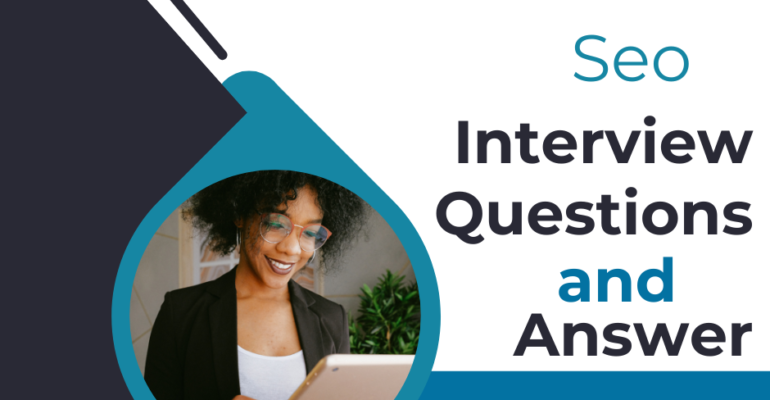Seo Interview Question And Answer
Seo Interview Question And Answer
1. What Is SEO?
SEO (Search Engine Optimization) is the process of optimizing a website to improve its visibility in search engine results pages (SERPs).
2. What Are the Different Types of SEO?
- On-Page SEO – Optimizing content, HTML, and structure.
- Off-Page SEO – Building backlinks, social signals, etc.
- Technical SEO – Improving site speed, mobile-friendliness, indexing.
3. What Is a Search Engine?
A search engine is a platform that helps users find information on the internet. Example: Google, Bing, Yahoo.
4. What Are Organic and Paid Results?
- Organic results appear naturally in search engines based on SEO.
- Paid results are ads displayed above or below organic results.
5. What Are Keywords in SEO?
Keywords are words or phrases that users type into search engines to find content.
6. What Are Long-Tail Keywords?
Long-tail keywords are longer, more specific phrases with lower competition but higher conversion rates. Example: “Best budget smartphone under ₹10,000”.
7. What Is a Backlink?
A backlink is a link from one website to another. It helps improve domain authority and SEO rankings.
8. What Is Internal Linking?
Internal linking connects pages within the same website, helping users navigate and improving SEO.
9. What Are Meta Tags?
Meta tags provide search engines with information about a webpage. Common meta tags:
- Meta Title – Defines the page title.
- Meta Description – Short summary of the page.
10. What Is a SERP?
SERP (Search Engine Results Page) is the page that appears after a user enters a query into a search engine.
11. What Is the Ideal Length of a Meta Title?
The ideal length is 50–60 characters to ensure visibility in search results.
12. What Is the Ideal Length of a Meta Description?
The ideal length is 150–160 characters for optimal readability in SERPs.
13. What Is Keyword Density?
Keyword density is the percentage of times a keyword appears in content compared to the total word count. Ideally, it should be 1-2%.
14. What Is Image Optimization in SEO?
Optimizing images by reducing file size, using alt text, and compressing images to improve loading speed.
15. What Is the Importance of Heading Tags (H1-H6)?
Heading tags improve content structure and readability.
- H1 – Main title
- H2-H6 – Subheadings
16. What Is an XML Sitemap?
An XML sitemap lists all important website URLs, helping search engines index content.
17. How Do You Optimize Content for SEO?
- Use keywords naturally.
- Write high-quality, unique content.
- Add internal and external links.
18. What Is Duplicate Content?
Duplicate content is when the same content appears on multiple web pages, harming SEO.
19. What Is a Canonical Tag?
A canonical tag (rel=”canonical”) tells search engines which version of a URL is the preferred one.
20. What Is Schema Markup?
Schema markup is a form of structured data that helps search engines display rich results (stars, FAQs, etc.).
21. What Are the Best Off-Page SEO Techniques?
- Backlink building
- Social media marketing
- Guest blogging
- Influencer outreach
22. What Are Do-Follow and No-Follow Links?
- Do-Follow Links pass link juice and help in rankings.
- No-Follow Links do not pass link juice but still provide traffic.
Example:
Do-Follow Link: <a href=”https://www.example.com”>Example</a>
No-Follow Link: <a href=”https://www.example.com” rel=”nofollow”>Example</a>
Why Use No-Follow Links?
- To prevent passing SEO value to external or potentially untrustworthy sites.
- For paid advertisements or sponsored content, as required by search engine guidelines.
23. What Are High-Quality Backlinks?
Backlinks from authoritative, relevant websites with high domain authority (DA).
24. How Do You Check the Quality of a Backlink?
Use Ahrefs, Moz, or SEMrush to analyze:
- Domain Authority (DA)
- Page Authority (PA)
- Spam Score
25. What Is Guest Blogging in SEO?
Writing articles for other websites in exchange for backlinks.
26. What Is Page Speed?
Page speed is how fast a webpage loads. Faster loading improves SEO rankings.
27. How Can You Improve Page Speed?
- Compress images
- Use a caching plugin
- Minify CSS and JavaScript
- Use a Content Delivery Network (CDN)
28. What Is Mobile-First Indexing?
Google indexes and ranks websites based on their mobile version first.
29. What Are Core Web Vitals?
Google’s ranking factors that measure user experience:
- LCP (Largest Contentful Paint) – Loading speed
- FID (First Input Delay) – Interactivity
- CLS (Cumulative Layout Shift) – Visual stability
30. How Can You Fix Broken Links?
Use tools like Google Search Console or Ahrefs to find broken links and redirect them using a 301 redirect.
31. What Is Google My Business (GMB)?
Google My Business is a free tool that allows businesses to appear in local search results and Google Maps.
32. How Do You Optimize Google My Business?
- Add accurate business details
- Post updates regularly
- Get customer reviews
- Add photos & services
33. What Is NAP Consistency?
NAP (Name, Address, Phone Number) consistency means having the same business details across all online directories.
34. How Do You Rank in Local SEO?
- Optimize Google My Business
- Get local backlinks
- Use location-specific keywords
35. What Is Citation in Local SEO?
A citation is an online mention of your business (NAP) on directories like Yelp, Yellow Pages, etc.
36. What Are the Best SEO Tools?
- Google Search Console
- Google Analytics
- SEMrush
- Ahrefs
37. What Is Google’s Panda Algorithm?
Google Panda penalizes low-quality, thin, or duplicate content.
38. What Is Google’s Penguin Algorithm?
Penguin penalizes spammy backlinks and over-optimized anchor text.
39. What Is Google’s Hummingbird Algorithm?
Hummingbird improves semantic search and natural language understanding.
40. What Is Google’s E-A-T?
E-A-T stands for Expertise, Authoritativeness, and Trustworthiness—important for ranking quality content.
41. What Is Voice Search Optimization?
Optimizing content for voice searches using conversational and long-tail keywords.
42. How Do You Recover From a Google Penalty?
- Identify the issue in Google Search Console.
- Remove spammy backlinks.
- Improve content quality.
43. What Is Link Juice?
Link juice is the SEO value passed from one page to another through backlinks.
44. How Do You Perform a Site Audit?
Use tools like Screaming Frog, SEMrush, or Ahrefs to check:
- Broken links
- Page speed
- Duplicate content
- Indexing issues
45. What Is Mobile SEO?
Mobile SEO ensures that a website is optimized for mobile users by improving:
- Mobile-friendly design (responsive layout)
- Fast page load speed
- Proper viewport settings
46. How Does Google Search Console Help in SEO?
Google Search Console provides insights into:
- Indexing issues
- Crawl errors
- Backlink reports
- Keyword performance
47. What Is Robots.txt?
The robots.txt file guides search engines on which pages to crawl or avoid.
Example: Blocking Search Engines from Crawling an Admin Page
User-agent: *
Disallow: /admin/
48. How Do You Fix a Website That Is Not Indexing?
- Check robots.txt to ensure pages are not blocked.
- Submit sitemap.xml in Google Search Console.
- Ensure pages are not set to “noindex” in meta tags.
- Improve internal linking.
49. What Are HTTP and HTTPS?
- HTTP (HyperText Transfer Protocol) – Not encrypted.
- HTTPS (Secure HTTP) – Uses SSL encryption, improving security & SEO.
50. How Do You Migrate a Website Without Losing SEO?
- Set up 301 redirects from old URLs to new ones.
- Update internal links.
- Submit the new sitemap in Google Search Console.
51. How Is AI Changing SEO?
- AI tools (like ChatGPT, Google Gemini) improve content generation.
- Google’s RankBrain & BERT use AI for better search understanding.
52. What Is Google RankBrain?
RankBrain is Google’s AI algorithm that understands search intent better.
53. How Does BERT Algorithm Impact SEO?
BERT helps Google understand context in searches, improving results for long-tail queries.
54. What Is Google MUM?
Google MUM (Multitask Unified Model) is an AI algorithm that:
- Understands multiple languages.
- Processes text, images, and videos for better search results.
55. How Can AI Be Used for Keyword Research?
AI tools like Surfer SEO, Clearscope, and Frase analyze search trends and suggest high-ranking keywords.
SEO Analytics & Reporting
56. How Do You Measure SEO Performance?
Use:
- Google Analytics (traffic, bounce rate, conversions).
- Google Search Console (clicks, impressions, CTR).
- Ahrefs/SEMrush (backlinks, keyword rankings).
57. What Is Bounce Rate?
Bounce rate is the percentage of visitors who leave without interacting with the page.
58. What Is Dwell Time?
Dwell time is the time a user spends on a page before returning to search results.
59. What Is Click-Through Rate (CTR)?
CTR = (Clicks ÷ Impressions) × 100
Example:
If 100 people see your page in search results and 10 click on it, your CTR is 10%.
60. How Do You Improve CTR?
- Use compelling meta titles & descriptions.
- Add numbers or brackets (e.g., “Top 10 SEO Tricks [2025]”).
- Use schema markup for rich snippets.
61. How Would You Rank a New Website?
- Keyword Research – Find low-competition keywords.
- Technical SEO – Ensure fast speed, mobile-friendliness.
- Content Strategy – Publish high-quality articles.
- Backlinks – Guest posts, outreach, citations.
62. What Would You Do If Your Website Traffic Dropped Suddenly?
- Check Google Search Console for penalties.
- Analyze Google algorithm updates.
- Fix broken backlinks and update old content.
63. What Is a 301 Redirect?
A 301 redirect permanently moves a page to a new URL.
Example (in .htaccess file):
Redirect 301 /old-page/ https://example.com/new-page/
64. What Is a 404 Error? How to Fix It?
A 404 error occurs when a page is not found. Fix it by:
- Redirecting broken URLs.
- Restoring missing pages.
65. How Do You Remove a URL from Google Search?
Use Google Search Console → Removals to temporarily remove a URL.
66. What Are White Hat and Black Hat SEO?
- White Hat SEO – Ethical methods (content, quality backlinks).
- Black Hat SEO – Unethical methods (keyword stuffing, spammy links).
67. What Is the Skyscraper Technique?
- Find high-ranking content in your niche.
- Create a better version of it.
- Outreach to websites linking to the old content.
68. How Do You Build High-Quality Backlinks?
Guest Blogging Broken Link Building HARO (Help a Reporter Out) Influencer Outreach
69. What Is Anchor Text in SEO?
Anchor text is the clickable text in a hyperlink.
Example:
<a href=”https://example.com”>Best SEO Guide</a>
70. How Many Backlinks Does a Page Need to Rank?
There is no fixed number. Quality is more important than quantity.
71. How Do You Rank Higher in Google Maps?
- Optimize Google My Business.
- Get local citations.
- Earn positive reviews.
72. What Is Geotagging in SEO?
Adding location data to images and content to rank in local searches.
73. How Important Are Reviews for Local SEO?
Positive reviews boost local rankings and conversions.
73. Will SEO Still Be Important in 2025?
Yes, but voice search, AI, and user experience will play a bigger role.
74. What Are Web Stories in SEO?
Short, mobile-friendly visual stories that appear in Google Discover.
75. How Will Video SEO Impact Rankings?
Optimized YouTube & video content will appear in search results more often.
76. How Do You Submit a Sitemap to Google?
- Go to Google Search Console.
- Click on Sitemaps.
- Enter the sitemap URL (e.g., https://example.com/sitemap.xml).
- Click Submit.
77. What Is the Difference Between a Static and a Dynamic URL?
- Static URL – Remains the same (e.g., example.com/about-us).
- Dynamic URL – Changes based on parameters (e.g., example.com/page?id=123).
78. What Is Page Speed Optimization?
Page speed optimization improves website loading time using:
- Image compression (WebP, JPEG optimization)
- Minification of CSS, JavaScript, HTML
- Using a Content Delivery Network (CDN)
79. What Is Core Web Vitals?
Google’s Core Web Vitals measure:
- Largest Contentful Paint (LCP) – Page load speed.
- First Input Delay (FID) – Interactivity speed.
- Cumulative Layout Shift (CLS) – Visual stability.80. How Do You Improve Core Web Vitals?
- Reduce server response time.
- Optimize images & lazy load them.
- Minimize CSS & JavaScript blocking time.
81. What Is the Difference Between Crawling and Indexing?
- Crawling – Search engines scan pages.
- Indexing – Crawled pages are stored in Google’s database.
82. What Is a Canonical Tag?
A canonical tag (rel=”canonical”) prevents duplicate content issues by telling search engines which page is the original version.
Example:
<link rel=”canonical” href=”https://example.com/original-page/”>
83. What Is Hreflang Tag?
Hreflang tags help Google serve the correct language version of a webpage to users.
Example for English & Spanish versions:
<link rel=”alternate” hreflang=”en” href=”https://example.com/en/”>
<link rel=”alternate” hreflang=”es” href=”https://example.com/es/”>
84. How Will Voice Search Impact SEO?
- More conversational, long-tail keywords.
- Focus on FAQs & featured snippets.
- Optimize for “Near Me” searches.
85. What Is Google Search Generative Experience (SGE)?
SGE is Google’s AI-powered search, providing direct AI answers in results.
86. What Is Entity-Based SEO?
Google now focuses on entities (people, places, things) rather than just keywords.
Example: If you search for “Elon Musk,” Google recognizes him as an entity, not just words.
87. What Is E-E-A-T?
E-E-A-T stands for:
- Experience
- Expertise
- Authoritativeness
- Trustworthines
Google ranks pages higher based on real experience & credibility.
88. What Is Google Discover?
Google Discover shows personalized content based on user interests & browsing habits.
89. What Are Multimodal Searches?
Multimodal searches allow users to search using text, images, and voice together (e.g., Google Lens).
90. What Is the Future of SEO?
SEO will focus on:
- AI-generated content & ranking algorithms.
- Zero-click searches & featured snippets.
- Voice & video search optimization.








